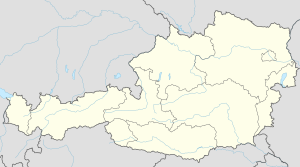Wienerwaldtunnel
| Wienerwaldtunnel | ||
|---|---|---|
|
West portal of the Wienerwald tunnel in Tullnerfeld
|
||
| use | Railway tunnel | |
| traffic connection | Western Railway | |
| place | Vienna , Lower Austria | |
| length | 13.356 km | |
| Number of tubes | 1 tube coming from the east, 2 tubes coming from the west | |
| cross-section | Double track coming from the east, single track coming from the west | |
| construction | ||
| Client | ÖBB Infrastruktur Bau AG, Vienna | |
| building-costs | 617 million euros | |
| start of building | September 2004 | |
| completion | at the end of 2012 | |
| business | ||
| operator | ÖBB | |
| location | ||
|
|
||
| Coordinates | ||
| West portal | 48 ° 17 ′ 5 " N , 16 ° 4 ′ 56" E | |
| East portal | 48 ° 12 ′ 37 " N , 16 ° 13 ′ 22" E | |
The Wienerwaldtunnel is a 13.356 km long railway tunnel of the new Westbahn between the outskirts of Vienna and the Tullnerfeld in operation since December 9th, 2012 . The tunnel goes under the ridge between Gablitz and Mauerbach in the northern part of the Vienna Woods . The Wienerwaldtunnel is the third longest railway tunnel in Austria .
The east portal is located underground in the turnout hall near Hadersdorf-Weidlingau, which had already been built in advance, and continues in the direction of Vienna through the Lainzer tunnel , into which it merges underground. The west portal is located between Chorherrn (municipality of Tulbing) and Klein Staasdorf south of Tulln and continues in the direction of St. Pölten through the Perschling tunnel chain .
Since the section between Vienna and St. Pölten went into operation, travel time between the cities has only been 25 minutes; before that, the fastest trains took over 40 minutes.
The structure is part of the new Westbahn and thus part of the European high-performance axis Paris-Budapest / Bratislava of the Trans-European Networks for Transport (TEN-V) as a priority project TEN-T17.
construction

The tunnel, which was built between September 2004 and December 2012, was driven from both sides. In the east, an approximately 2,300 m long single-tube, double-track section was built using the New Austrian Tunneling Method . The remaining part was milled from the west with two shield tunneling machines. Two single-track tubes were built in this area. Tunneling began in autumn 2005.
Some of the excavated material was temporarily stored in order to later be used for the construction of the new railway line in Tullnerfeld as bulk material for railway and noise barriers. Another part of the material was used to redesign the Taglesberg in the Vienna Woods, where a new, artificial ridge is to be created in a landfill rehabilitation area.
The tunnel breakthrough took place on September 3, 2007. It was completed in 2012 with the new section of the new western line from Vienna - St. Pölten . The construction costs were 617 million euros.
The contact line was put under tension on May 6, 2012.
Commercial commissioning took place on December 9, 2012. At the same time, the Lainzer Tunnel and the first four tracks of Vienna Central Station went into operation.
Today all long-distance traffic on the western railway line runs through this tunnel.
business
The Wienerwald tunnel has been driven through as planned since December 9, 2012. Around 80 trains pass each day in each direction (both passenger trains and freight trains), a Railjet or ICE takes less than 5 minutes at a speed of 230 km / h.
Safety devices
The two tubes are connected by cross tunnels at a distance of around 500 m. There is also an emergency ventilation shaft and four exit tunnels.
facts and figures
- Excavation material: approx. 2.3 million m³
- Tubbing for expanding the tubes: approx. 57,000 pieces
- Top speed: 250 km / h
The structure is equipped with ETCS Level 2 and - as a fall-back level - with conventional light signals. These are to be dismantled when the ETCS system has proven to be sufficiently stable.
literature
- The Wienerwaldtunnel - a tunnel construction challenge . In: Geotechnik , Issue 2/2006, pp. 167–172.
Web links
Individual evidence
- ↑ a b c d New line Vienna Hadersdorf - St. Pölten completed . In: Eisenbahn Österreich , issue 8–9 / 2012, p. 381 f.


